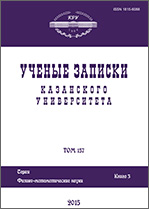|
This article is cited in 3 scientific papers (total in 3 papers)
About the use of the Stokes number for mathematical modeling of two-phase jet flows
Yu. V. Zuev
Moscow Aviation Institute (National Research University), Moscow, 125993 Russia
Abstract:
The appropriateness of using the Stokes number as a single
similitude parameter for representation of the results of research
on two-phase jet flows in a criteria form was considered. Numerical
modeling with the help of the developed mathematical model of a
two-phase turbulent jet was applied. After putting the equations of
this model in the dimensionless form, the similitude parameters
needed for two-phase turbulent jet flow modeling were obtained. One
of the criteria for dynamic similarity is the Stokes number, which
can be presented as a product of the Reynolds number, the relative
diameter of particles, and the relative density of phases. It was
shown that the value of the Stokes number is uniquely related to
changes in the parameters of the two-phase jet only when its value
is smaller than 0.14–0.15. The two-phase jet flows can be
geometrically and kinematically similar at higher values of the
Stokes number if the equality of the following three criteria of
similarity are maintained: Reynolds numbers, relative diameter of
particles, and relative density of phases. The obtained results
allow avoiding gross errors during generalization of experimental
and analytical data on two-phase turbulent jet flows.
Keywords:
two-phase jet, gas, particle, criteria of similarity, calculation results.
Received: 21.06.2019
Citation:
Yu. V. Zuev, “About the use of the Stokes number for mathematical modeling of two-phase jet flows”, Uchenye Zapiski Kazanskogo Universiteta. Seriya Fiziko-Matematicheskie Nauki, 161, no. 3, Kazan University, Kazan, 2019, 341–354
Linking options:
https://www.mathnet.ru/eng/uzku1522 https://www.mathnet.ru/eng/uzku/v161/i3/p341
|

| Statistics & downloads: |
| Abstract page: | 273 | | Full-text PDF : | 258 | | References: | 38 |
|




 Contact us:
Contact us: Terms of Use
Terms of Use
 Registration to the website
Registration to the website Logotypes
Logotypes








 Citation in format
Citation in format 
